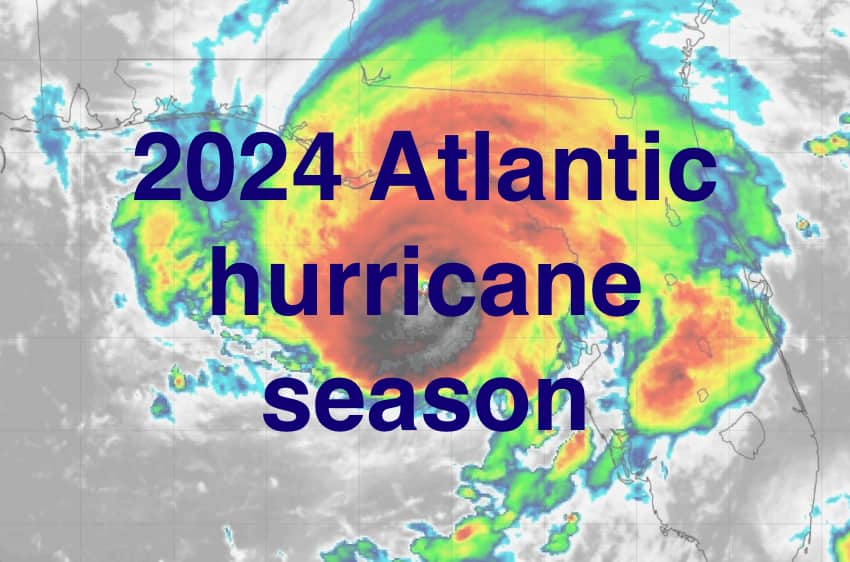CSU forecasts well-above average major hurricane landfall probability for 2024 season

Colorado State University’s tropical meteorology team led by Phil Klotzbach have issued their first forecast for the 2024 Atlantic hurricane season, estimating that 23 named storms, 11 hurricanes and 5 major hurricanes will be seen, while landfall probabilities are also forecast to be elevated.
Released just minutes ago, the Colorado State University (CSU) tropical meteorology team is the latest to call for a particularly busy hurricane season in 2024.
Phil Klotzbach said in announcing the forecast that it anticipates a “very active hurricane season.”
The forecast from CSU calls for 23 named tropical storms to form in the Atlantic during the season from June 1st to November 30th.
11 of those named storms are forecast as likely to become hurricanes, with 5 of those forecast to become major hurricanes with Category 3 sustained wind speeds of 111 mph or greater.
In addition, the CSU team forecasts that accumulated cyclone energy (ACE) for the 2024 hurricane season will reach 210.
Perhaps more pertinent to the insurance, reinsurance, catastrophe bond and insurance-linked securities (ILS) community, the CSU forecast team calls for an ACE Index score of 125 to the west of 60 degrees longitude, so closer to the United States coast and Gulf of Mexico.
They explain, “ACE generated west of 60 degrees west correlates better with landfalling storms in the Atlantic basin than basin-wide ACE, since virtually all hurricane-prone landmasses in the Atlantic Ocean are located west of 60 degrees west.
“Generally, a slightly lower percentage of basinwide ACE occurs west of 60 degrees west in El Niño years relative to La Niña years. Since the team anticipates La Niña as the most likely outcome in 2024, the percentage of basinwide ACE occurring west of 60 degrees west is predicted to be higher than last year.”
In total, there are forecast to be 115 days with named storms in the water, 45 days with hurricanes and 13 days with major hurricanes over the course of the coming season.
Describing the meteorological conditions, the CSU team states, “Current El Niño conditions are likely to transition to La Niña conditions this summer/fall, leading to hurricane-favorable wind shear conditions.
“Sea surface temperatures in the eastern and central Atlantic are currently at record warm levels and are anticipated to remain well above average for the upcoming hurricane season.
“A warmer-than-normal tropical Atlantic provides a more conducive dynamic and thermodynamic environment for hurricane formation and intensification.”
They also state that, “This forecast is of above-normal confidence for an early April outlook.”
Adding, “We anticipate a well above-average probability for major hurricanes making landfall along the continental United States coastline and in the Caribbean.”
Which is also particularly pertinent for the insurance, reinsurance, cat bond and ILS market, although naturally it does only require one landfalling storm for it to be a costly year.
The CSU team predicts with its forecast, that 2024 hurricane season activity levels will be about 170% of the average season from 1991–2020. For comparison, 2023 was around 120%.
On landfall probabilities specifically, the CSU team predict a 62% chance of major hurricane landfall for the entire U.S. coastline (average from 1880–2020 is 43%).
They give a 34% probability of a major hurricane landfall for the U.S. East Coast, including the Florida peninsula (average from 1880–2020 is 21%).
A 42% chance of major hurricane landfall for the Gulf Coast from the Florida panhandle westward to Brownsville (average from 1880–2020 is 27%) and a 66% probability of major hurricane landfall for the Caribbean (average from 1880–2020 is 47%).
Notable for the reinsurance, catastrophe bond and ILS market, the team gives a 44% probability of a major hurricane landfall for Florida alone, based on a probability of one or more events within 50 miles of the state, higher than the climatological average of 29%.
Readers know that we’ve tracked the hurricane season for many years, to supplement our normal coverage with information of relevance to the insurance-linked securities (ILS), catastrophe bond and reinsurance markets.
We always like to look at the Artemis Average across the forecasters we track and now with four recorded on our dedicated hurricane season page, the average forecast calls for 23 named storms, 11 hurricanes, 5 major hurricanes and an ACE Index score of 198, so pretty close to the CSU April forecast.
We only include full season forecasts in this average, so not the ECMWF one we list as that only covers the Atlantic through September.
Track the 2024 Atlantic tropical storm and hurricane season on our dedicated page and we’ll update you as new information emerges.






